Despite its small size, Aaniiih Nakoda College is running two multimillion dollar research centers. Is this the future of tribal colleges?
By Paul Boyer
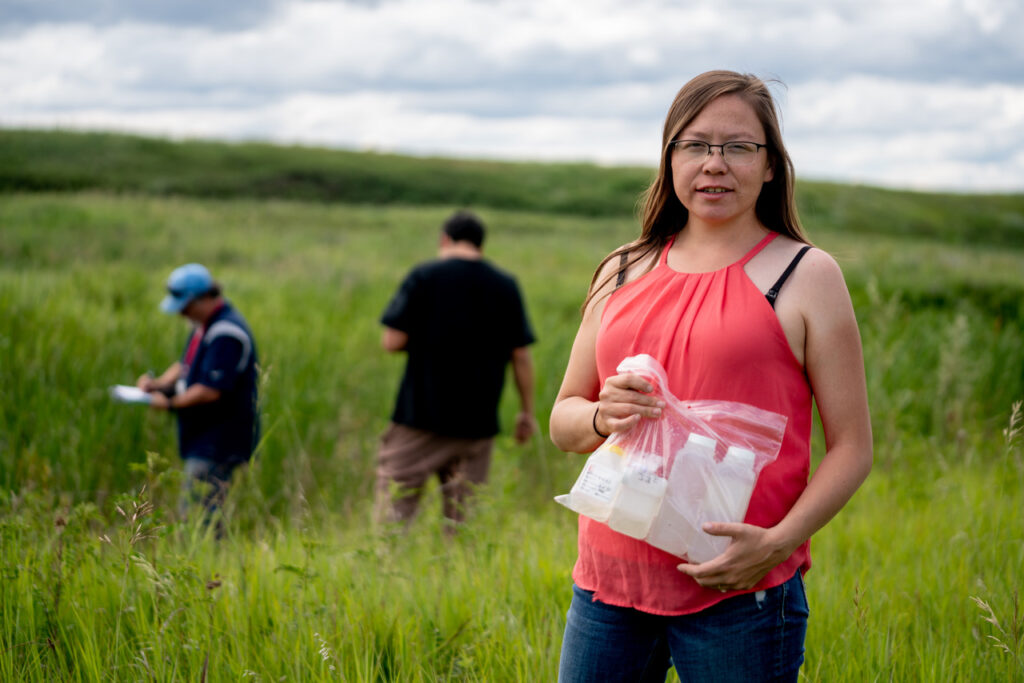
On a drizzly afternoon in early summer two vans maneuver cautiously down a muddy dirt road on the southern edge of the Fort Belknap Reservation in Montana and park by the side of a small mountain stream. A half dozen people—all members of the tribe— climb out, pull on waders, step over tall grass, and drop into the water.
One, positioned upstream, begins to vigorously kick the streambed. Two others, standing downstream, hold down a fine-mesh net, which quickly fills with the loosened mud. After one minute, the kicking stops, the sediment is transferred to a container and everyone, after a brief rest, a few cigarettes, and some lighthearted teasing, get back in their vehicles and drive away.
The tribal members are all affiliated with the Nicʔ-Mní Center, a four-year-old research center started by Aaniiih Nakoda College that is investigating the health of reservation waterways. The specific goal this day is to identify the amount and variety of life in several important streams. More is better and this particular location—a stretch of Peoples Creek—is in reasonably good shape. Standing at the stream’s edge, faculty member Dan Kinsey said they can expect to collect hundreds of diptera, midge, and mayfly larvae in their kick nets.
Other creeks, however, are in very poor health, made nearly lifeless by runoff from open pit gold mines found just off the reservation. These mines are now closed but they continue to drain highly acidic water, and will “in perpetuity,” according to the Montana Department of Environmental Quality, which is now responsible for managing the mine as a Superfund site. A variety of mitigation efforts dot the barren hillside and surrounding forests, including two water treatment plants that, working around the clock, filter some of the runoff. Even so, the most contaminated creeks periodically flow a disturbing shade of red and elevated levels of arsenic and other harmful chemicals are still present.
The reservation is not responsible for the damage done, but it bears the brunt of the environmental scaring and, while the state of Montana has a legal mandate to manage the site, it is the tribe and the college that have taken on the day-to-day work of documenting the progress made. Despite limited resour college’s research center has amassed more data than the state or federal government and can speak with greater authority on the health of waterways and groundwater. When an effort was recently made to restart mining, data collected by the college’s research center and the tribe provided evidence needed to bring it to a halt.
The growing role of research
Research is not entirely new at tribal colleges. Even in their early years, some STEM instructors made time for their own scholarship, despite heavy teaching loads. The late Bob Madsen, who taught at both Little Big Horn College and Chief Dull Knife College in Montana (and often noted that he was, at both institutions, a STEM “faculty of one”) spent decades studying the spread of the West Nile Virus during summer breaks. Many faculty also integrated research experiences into their classes, part of an effort to “learn science by doing science.”
What has changed in recent years is the degree to which research has been prioritized and institutionalized. More than an enrichment for students or the extracurricular activity of faculty, it is now part of the core mission within a growing number of colleges.
Much of this work is supported by grants from federal agencies. The Department of Agriculture’s National Institute for Food and Agriculture (NIFA), for example, funds research and academic programs related to land use, water policy, and other issues of concern to land-grant institutions. NASA and the Howard Hughes Medical Institute, among others, have also helped build research capacity within tribal colleges.
However, the agency most responsible for this transformation is the National Science Foundation and, in particular, its Tribal Colleges and Universities Program (TCUP). Established over twenty years ago, TCUP has long provided funding for individual faculty-led projects under its Small Grants for Research (SGR) strand. Five years ago, however, TCUP created a new initiative to support development of interdisciplinary research centers capable of exploring larger issues affecting tribal communities.
These “Enterprise Advancement Centers,” as they are called, go “beyond the scope of individual research grants,” the NSF solicitation explains, by addressing “a critical tribal or community need” or focusing “on a realm of research…of interest to multiple tribes.”
Today, approximately one-third of all tribal colleges have established their own TCU Enterprise Advancement Centers. Each is thematic, with most addressing environmental and agricultural issues. Several, like Aaniiih Nakoda College’s Nicʔ-Mní Center, focus on water. Others are pursuing projects related to advanced manufacturing, Native language revitalization, and Indigenous research methodologies, among others.
TEA center awards—$3-$5 million, in most cases—are a tiny part of the nation’s total expenditure on research. (For comparison, Johns Hopkins University alone spent over $3 billion on R&D in 2021, according to data collected by the NSF.) But in communities where research capacity was, until recently, almost entirely absent, the development of these centers is significant and potentially transformative. Just as institutions like MIT and Stanford are seen as the nation’s engines of innovation in the sciences, so too are tribal colleges becoming, in their own way, the “research universities” of their Native nations.
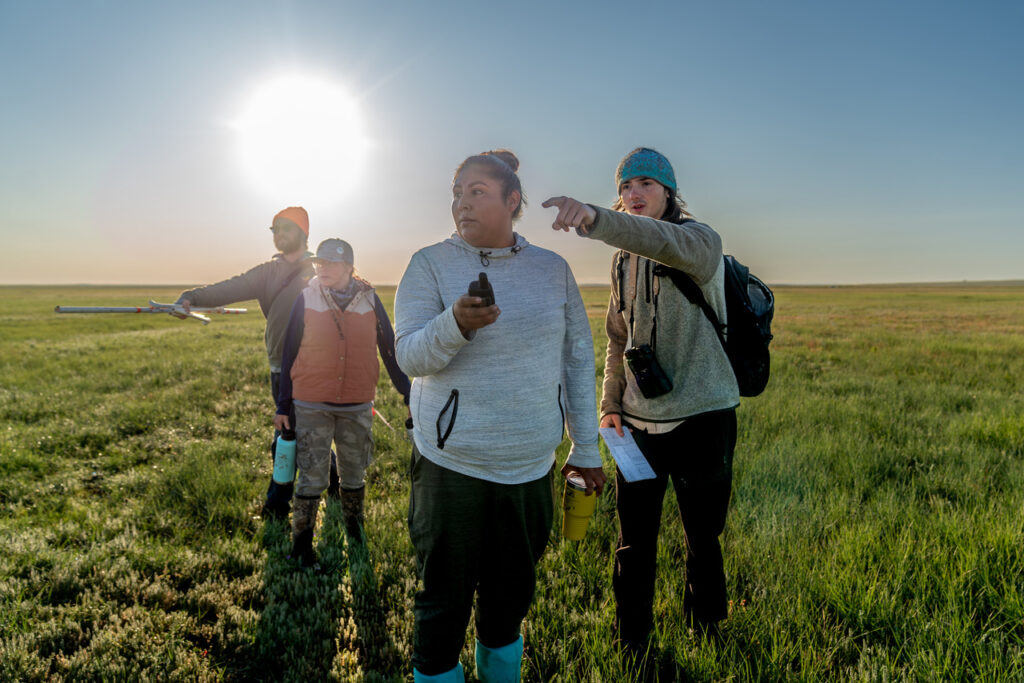
This vision is clearly seen at Aaniiih Nakoda College, which was founded in 1983 to serve the sparsely populated Fort Belknap Reservation of north central Montana. Like most other tribally controlled colleges, it began by offering a handful of associate degrees for students hoping to gain credentials needed for local employment or continued study at a mainstream university.
Today, the college remains a small institution, with enrollment hovering in the 200s, and most students still pursue one or two-year degrees in disciplines ranging from American Indian studies and business to allied health and industrial trades. However, the college has in recent years embarked on a purposeful effort to deepen its commitment to STEM. As Scott Friskics, director of sponsored programs, explained it, “We are trying to weave science into the center of the college.”
This is easily seen in the curriculum, which now includes a baccalaureate program in Aaniiih Nakoda Ecology, the college’s first four-year degree. But it’s even more evident in the institution’s rapidly expanding research agenda.
The roots of this effort reach back to the 1990s when the college established a water lab with funding from the EPA and began documenting pollution in reservation waterways. Additional awards supported a comprehensive study of mine-site soil. Funding for those projects ended, but the NSF’s Tribal Enterprise Advancement Center program allowed the college to revive—and significantly enlarge—much of this work. Today the Nicʔ-Mní Center (which is named after the Aaniinin and Nakoda words for water), is responsible for the ongoing analysis of macroinvertebrate life in streams flowing out of the mine and other water related research, including extensive groundwater studies. The center also hosts an annual Water Forum where policy issues are discussed and research findings are shared.
New buffalo center enlarges the research agenda
Even as the water center was just getting off the ground, Aaniiih Nakoda College received funding for a second, equally ambitious, research center, the ʔíítaanɔ́ɔ́nʔí́Tataǵ̨a (Buffalo) Research and Education Center, which is investigating the reservation’s prairie ecosystem and working to “restore and sustain the native ecology of the Fort Belknap Indian Community,” according to the college. The new project studies indigenous flora and fauna and, in partnership with the Smithsonian, the World Wildlife Fund, the tribe, and other research organizations, supports the reintroduction of several endangered species, including the black footed ferret and swift fox. Of particular importance, the center will also study the tribe’s herd of over 800 buffalo and investigate the role they play as “ecosystem engineers.”
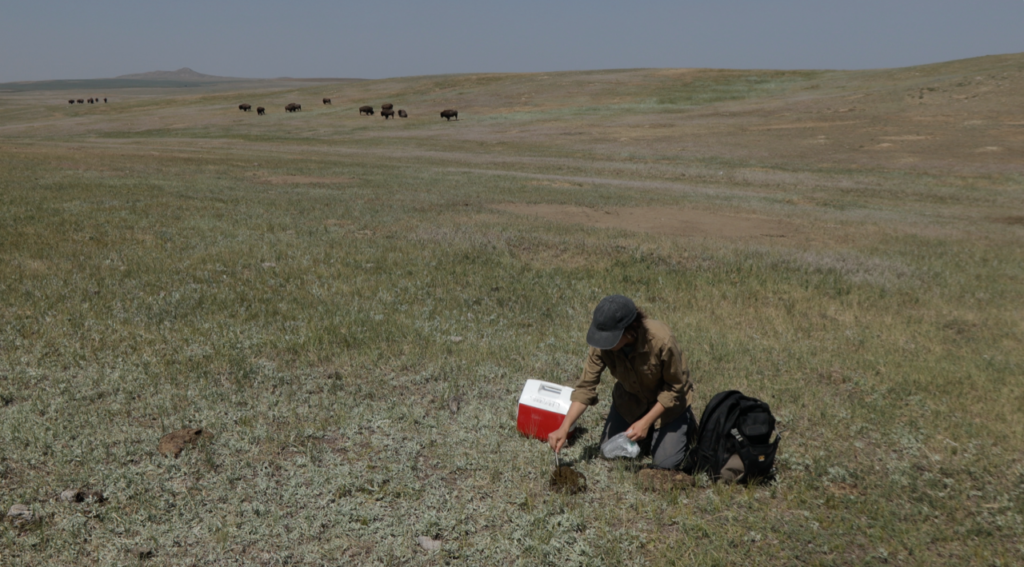
“Historically, buffalo played a central role not only in the lives of the Aaniinin and Nakoda nation, but in shaping the entire grassland ecosystem the people and buffalo inhabited together,” Friskics explained in the project’s grant proposal. Through grazing, trampling, and wallowing activities, they “were the single most important structural element of North American grassland ecosystems.” In a very real way, the American prairie was both shaped and sustained by their presence.
The purposeful slaughter of buffalo in the nineteenth century and conversion of grasslands to pasture by settlers destroyed the delicate and mutually beneficial relationships, leading to the decline of many species. By the start of the twentieth century, fewer than one thousand buffalo survived.
In recent decades, however, many western tribes have reestablished herds on reservation land. In eastern Montana, the Fort Peck Tribe maintains approximately 300 buffalo at two sites, one dedicated to conservation, the other maintained for hunting. The Blackfeet, Rosebud, and Rocky Boy reservations have all established or expanded their own herds in recent years. In 2018, after years of political wrangling, the National Park Service turned over management of the 19,000 acre National Bison Range, located on the Flathead Reservation, to the Confederated Salish and Kootenai Tribe.
Within this growing community of “buffalo nations,” the Fort Belknap Reservation’s herd is among the nation’s largest and its 29,000 acre reserve, a native prairie without any internal fencing, is one of the most expansive. Here, standing at an observation area at the Snake Butte buffalo pasture, it is possible to see them behaving as they did centuries ago—moving in large groups over the rolling hills, stopping to quietly graze, or, in sudden agreement, running en masse until they are mere dots on the horizon.
College administrators explain that this freedom of movement in large numbers over a relatively intact prairie ecosystem creates previously unavailable opportunities for research. Rather than studying individual animals, the center is beginning to study how buffalo and other species interact with each other, and with the larger environment.
Among the planned research projects, the center and its partners will investigate movement of buffalo over the prairie by applying GPS tags, which will identify areas that are most heavily used. Parallel analysis of flora and fauna throughout the range will help researchers understand how buffalo alter the habitats they use. Related studies, from bird and ungulate surveys to analysis of the rangeland’s soil and vegetation, will help paint a complex portrait of ecosystem relationships.
The center will also support ongoing efforts to reintroduce black footed ferrets, which were once plentiful across the plains, but disappeared when the prairie dog population went into decline.
“Black footed ferrets are obligate predators,” explained Mike Kinsey, an Aaniiih Nakoda College faculty member who previously worked for the tribes’ fish and wildlife department. “They only eat prairie dogs, and they rely on prairie dog colonies for sheltering and denning.” When prairie dogs started dying from sylvatic plague, spread by the same flea-borne bacterium that causes bubonic plague in humans, the ferret population plummeted. Simply put: No prairie dogs, no black footed ferrets.
Efforts to reintroduce ferrets date back a decade, but when the plague passed through the recovering prairie dog colonies in 2013, the tribe had to start over. In collaboration with the tribes’ fish and wildlife department, the college’s research center will simultaneously monitor the health of prairie dog colonies and support the release of more ferrets into the reservation’s two buffalo pastures.
Building community through research
No one really expected tribal colleges to become centers of research. “I don’t think there is a model for this,” Friskics said. “Accreditors come in and look at what our faculty are doing and their response is always the same: ‘Wow, that’s really unique for a community college.”
But college administrators say it is a natural extension of their mission to serve their tribal nations, and it is this community and student-centered approach that makes the tribal research college model unique in American higher education.
Unlike most universities, where research is shaped by the priorities of individual faculty and is used to build the institution’s reputation nationally (or internationally), Aaniiih Nakoda College’s research centers are a direct response to reservation needs and priorities. The decision to develop a water center, for example, was based on findings from a community survey. When asked to identify their top environmental concerns, “95 percent of the people in the survey said water,” Friskics said.
Similarly, the buffalo center grew out of the tribes’ deep cultural connection to buffalo, and supports the ongoing work of the tribes’ environmental and wildlife departments.
Supporting the community also means supporting students. While research and teaching are typically viewed as separate, even competing, activities within universities, Aaniiih Nakoda College actively works to weave students into research projects. “Our institutional research policy requires students to be involved in any research,” Frickics said. “It’s mandatory.” Students can be found working alongside faculty as interns and research assistants, and the centers also incorporate educational programs, such as cultural encampments and jump start academies for high school students.
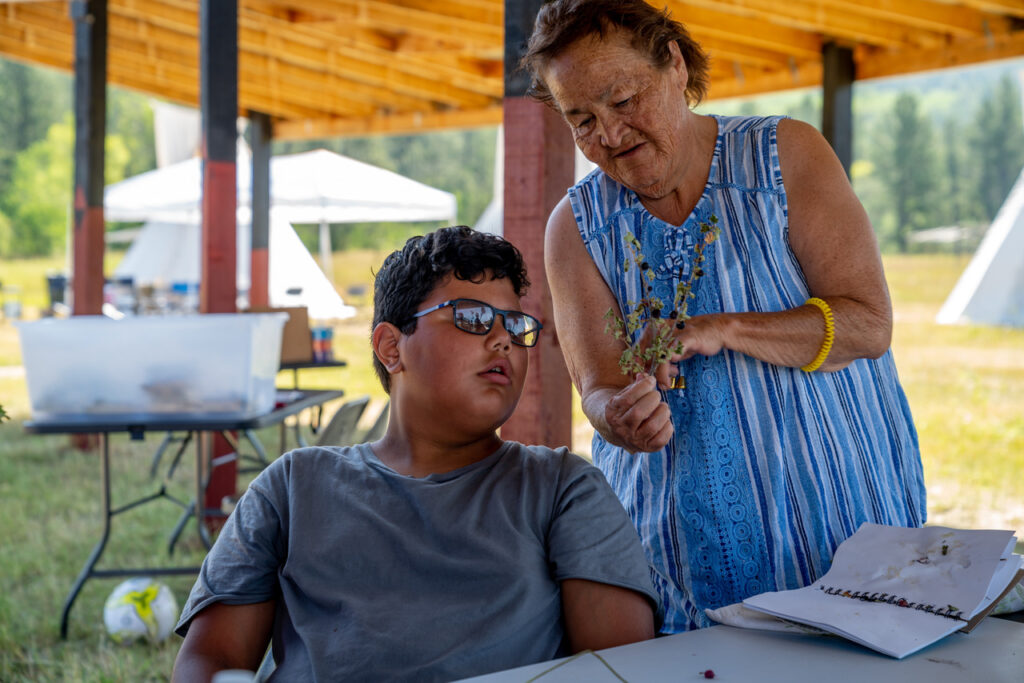
Bringing secondary school students into the center’s work will, college officials hope, lead some to purse STEM careers and, more broadly, create a stronger appreciation for the value of research within the community.
“Ultimately, it’s a sovereignty issue,” Friskics said. “Are we going to have contractors come in and do the work for us, or is there going to be home-grown capacity? I think research skills and research knowledge are important for future decision-makers. These are tools the community needs to have.”
Observation as science
Among some scientists, much of the work conducted by the two centers might not be considered “research” at all, at least as the term is understood in the western academic tradition.
“From that perspective, research is supposed to have a well defined research question. That’s how western science works,” Friskics said. “You pose your question and you go out to find your answer.”
In contrast, he continued, much of the work conducted by the water and buffalo centers is “what people disparagingly refer to as ‘monitoring’: You’re not asking a research question; you’re just gathering information about what’s out there. That goes against the grain, a little bit, of western science.”
However, monitoring very much reflects the Indigenous approach to research. As Tewa scholar Gregory Cajete argued, Native science does not have a tradition of conducting controlled experiments, which he defined as a “deliberate attempt to distort a natural event.” Instead, it relies on observation and, especially, the observation of systems.
“Native science stems from a deeply held philosophy of proper relationships with the natural world that is transferred through direct experience with a landscape,” he explained in his book, Native Science: Natural Laws of Interdependence. It seeks “meaning and understanding,” without needing to “predict and control.”
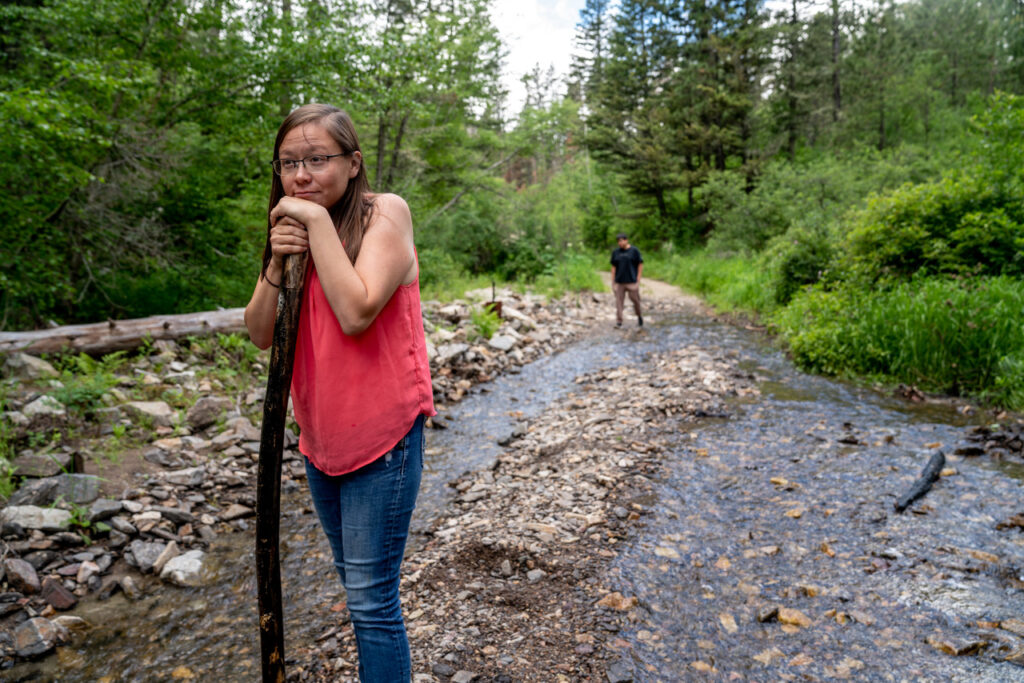
This mindset shapes the work of the college, where much of the water center’s activity focuses on data gathering—going back to the same streams and wells again and again, year after year. It’s an approach that takes the long view and does not demand yes or no answers to a research hypothesis. Saying, “Let’s just monitor water for a decade” allows knowledge to unfold, Friskics said, and is “in tune with people who have lived in a place for a long time.”
The college is not rejecting western science. Indeed, their water monitoring purposefully follows EPA guidelines so that data will have standing in courts and the larger academic community. But the value placed on long term observation moves the college’s research agenda to a different conceptual space. Less preoccupied with what Friskics calls the “interrogation of nature,” it looks for patterns and relationships. It seeks to sustain, not disrupt, natural systems.
It also allows the college to broaden the definition of ‘scientist.’ It recognizes that expertise can be found throughout a community.
“It is a model that anyone can do,” Friskics said.
In mainstream society this work is often called “citizen science” and is employed in backyard bird surveys and efforts to document the effects of climate change in local ecosystems. But this approach was long part of Native communities, which assumed that all members participated, daily, in the work of science. In this way, “Native science is a people’s science, a people’s ecology,” Cajete said. “People come to know and understand their relationship to the physical environment in which they work by what they do to live in that environment.”
Opportunities—and some risks
What is the future of research within tribal colleges? Will it continue to grow, or does it reflect a passing trend?
Much depends on funding, which is always uncertain. NSF-funded TEA Centers are supported in most cases by renewable five-year grants, but long-term funding depends on factors that the colleges cannot control, including the federal government’s own priorities. Thirty year ago, a Bush administration plan to solve reservation poverty through entrepreneurship resulted in many “small business development centers” at tribal colleges. All are now gone.
Another concern is that there is still limited understanding of Native science within the nation’s scientific community. While the Biden administration has worked hard to elevate what is often called “traditional ecological knowledge,” Friskics said research based on monitoring can be a hard sell when writing grants or submitting articles to research journals. “There are different ways of doing science, especially environmental science, and I wish there was more space for that,” Friskics said.
However, college administrators are hopeful that, despite obstacles, research will become a permanent part of the colleges and the communities they serve. Building research capacity opens doors to more funding from a wider range of agencies, he reasoned. Taking what he called a “faith-based” approach, he argued that pursuing one opportunity often leads to additional, unseen opportunities.
Done correctly, research can help strengthen institutions. Most tribal colleges have a limited pool of potential students. Serving small reservations, they will remain small colleges. But research provides opportunities for growth that do not depend on enrollment.
The danger is that research will come to dominate the institutions, altering their priorities, just as it does in mainstream research universities where scholarship thrives even as undergraduate teaching remains the unappreciated work of adjuncts and the untenured. At the moment, this seems unlikely. While mainstream colleges and universities seek to elevate themselves by becoming more selective and building national reputations through cutting-edge research, tribal colleges find validity in serving those who, historically, were least served by higher education. At Aaniiih Nakoda College, research exists to deepen this commitment to the reservation and its residents.
This mandate helps keep tribal colleges grounded, and when combined with new opportunities in research, it may indeed create a truly new kind of institution—the “tribal research university.”
Paul Boyer is editor of Native Science Report.
Story published October 30, 2023
• • •
Enjoyed this story? Enter your email to receive notifications.

An astounding article!